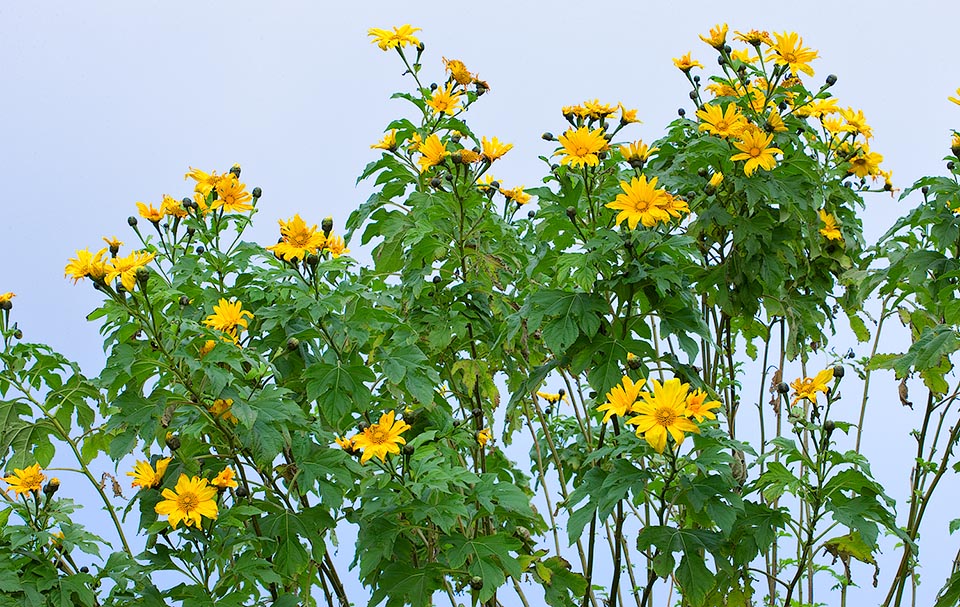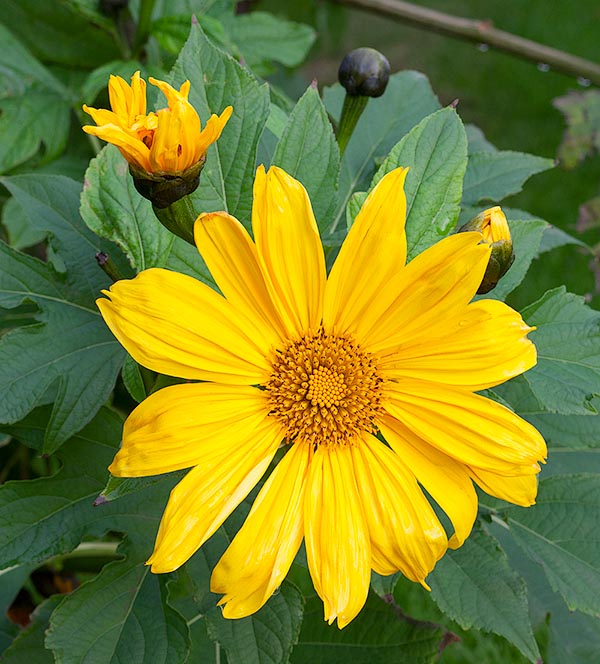Family : Asteraceae

Text © Pietro Puccio

English translation by Mario Beltramini
The species is native to Belize, Costa Rica, El Salvador, Guatemala, Honduras, Mexico (Campeche, Chiapas, Guerrero, Michoacan, Oaxaca, Quintana Roo, Sinaloa, Tabasco, Veracruz and Yucatan) where it grows in the thickets and savannahs, dry as well as humid, and in disturbed areas, from the sea level up to about 2000 m of altitude.
The name of the genus refers to a character of the Greek mythology, Τιθωνός (Tithonos) = Tithonus, son of king Laomedon and brother of Priam, king of Troy: the specific name is the combination of the Latin adjective “diversus, a, um” = different and of the substantive “folium, ii” = leaf, with obvious reference.
Common names: Bolivian sunflower, Japanese sunflower, Mexican sunflower, perennial sunflower, shrub-sunflower, tree marigold, wild sunflower (English); petite fleur soleil, tournesol medicai (French); kembang mbulan (Indonesian); margaridão-amarelo, girassol mexicano (Portuguese); amargoso, árbol maravilla, árnica, botón de oro, girasolillo, girasol mexicano, guasmara, jalacate, marbella, margarita, margaritón, mirasol, tanchiche (Spanish); denchamat-nam (Thai); dã quỳ (Vietnamese).

American tropical, tolerant also of temperate warm climates, Tithonia diversifolia is a fast growing stolonifeorus species herbaceous or shrubby, vigourous, very ramified and invasive. Can be 4 m tall. Its biomass is a good "green fertilizer”, able to enrich the soil of nitrogen, phosphorus and potassium, and a rich fresh fodder for ruminants © Giuseppe Mazza

Elegant perfumed capitula, medicinal properties and a repellent oil for the mosquitos © Giuseppe Mazza
Vigourous species of easy cultivation and fast growth, initially introduced as ornamental, due to the large and luminous flowers, in all tropical and subtropical countries, has escaped the cultivation in many areas of Africa and Asia naturalizing and entering into competition with the local flora, becoming a dangerous infester, despite the undeniable positive characteristics.
In fact, its biomass is one of the most effective “green fertilizers”, able to enrich the soil of nitrogen, phosphorus and potassium, and could represent a valid and economical alternative to the synthetic fertilizers. It is an excellent fresh fodder for the ruminants, rich in proteins and minerals, in particular calcium and phosphorus, that can be collected more times per year, when the plant is not in bloom and the contents of nutrients is maximum. Due to the fast growth it is able to create in short time border barriers and windbreaks and to control the erosion of the soils, thanks also to its ample rooting apparatus.
Cultivable in the tropical, subtropical and marginally milder temperate warm climate zones, possibly with damage to the aerial part, requires full sun and adapts to various types of soil, even poor, provided draining, and is moderately resistant to drought, even if it grows best in the zones having a well distributed annual rainfall over the 1000 mm. In the less favourable climates it can be easily cultivated as annual sowing in sheltered place in winter or directly on the spot in spring.
The leaves are utlized in the popular medicine for various pathologies, even if various studies have evidenced the presence of toxic effects at level of heart, liver and kidneys, on the other hand they have ascertained the presence of numerous bioactive compounds of possible interest for the official pharmacopoeia. The essential oil extracted from the leaves has a repellent action particularly effective towards the Anopheles gambiae sensu lato (complex of eight species practically indistinguishable), that is the main vector of malaria in the tropical African area.
Synonyms: Mirasolia diversifolia Hemsl. (1881); Urbanisol tagetiflora var. flavus Kuntze (1891); Urbanisol tagetiflora f. grandiflorus Kuntze (1891); Urbanisol tagetiflora var. diversifolius (Hemsl.) Kuntze (1891); Helianthus quinquelobus Sessé & Moc. (1894); Tithonia diversifolia subsp. glabriuscula S.F. Blake (1921).
→ To appreciate the biodiversity within the ASTERACEAE family please click here.
